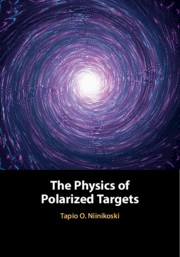Book contents
- The Physics of Polarized Targets
- The Physics of Polarized Targets
- Copyright page
- Dedication
- Contents
- Preface
- Acknowledgements
- 1 Introduction to Spin, Magnetic Resonance and Polarization
- 2 Resonance and Relaxation of Interacting Spin Systems
- 3 Electron Paramagnetic Resonance and Relaxation
- 4 Dynamic Nuclear Polarization
- 5 Nuclear Magnetic Resonance and Relaxation
- 6 NMR Polarization Measurement
- 7 Polarized Target Materials
- 8 Refrigeration
- 9 Microwave and Magnet Techniques
- 10 Other Methods of Nuclear Spin Polarization
- 11 Design and Optimization of Polarized Target Experiments
- Appendices
- Index
- References
3 - Electron Paramagnetic Resonance and Relaxation
Published online by Cambridge University Press: 03 February 2020
- The Physics of Polarized Targets
- The Physics of Polarized Targets
- Copyright page
- Dedication
- Contents
- Preface
- Acknowledgements
- 1 Introduction to Spin, Magnetic Resonance and Polarization
- 2 Resonance and Relaxation of Interacting Spin Systems
- 3 Electron Paramagnetic Resonance and Relaxation
- 4 Dynamic Nuclear Polarization
- 5 Nuclear Magnetic Resonance and Relaxation
- 6 NMR Polarization Measurement
- 7 Polarized Target Materials
- 8 Refrigeration
- 9 Microwave and Magnet Techniques
- 10 Other Methods of Nuclear Spin Polarization
- 11 Design and Optimization of Polarized Target Experiments
- Appendices
- Index
- References
Summary
The DNP phenomenoma are first overviewed basing on magnetic spin transitions and on thermal reservoirs, before turning to the microscopic and quantum statistical descriptions using the high-temperature approximation. The dynamic cooling of dipolar interactions is then extended to low temperatures and the stationary solution of Borghini is developed. The physical limits of the equal spin temperature model are discussed, focusing on the electron spin concentration, cross relaxation and hyperfine interactions, before treating the limitations arising from the heat transport, diffusion barrier, leakage factor and phonon bottleneck. The resolved and differential solid effect mechanisms are then presented before turning to the cross effect, Overhauser effect and DNP of hyperfine nuclei. The microwave frequency modulation effects are discussed in view of the “hole burning” due to limited cross relaxation and due to uneven power absorption cause by the magnetic dispersion and by inhomogeneity of the magnetic field.
Keywords
Information
- Type
- Chapter
- Information
- The Physics of Polarized Targets , pp. 98 - 154Publisher: Cambridge University PressPrint publication year: 2020
